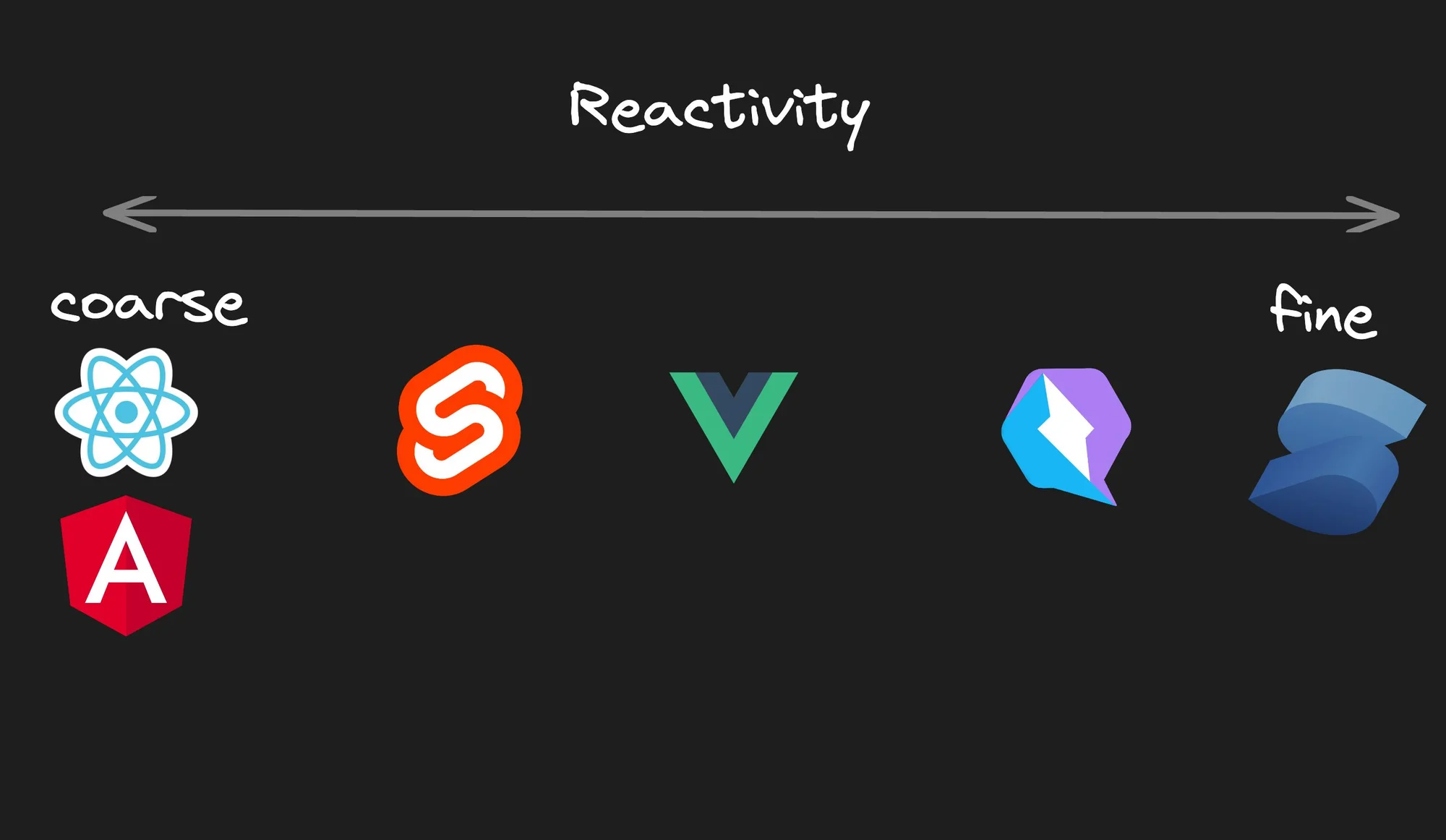Web端的反应式(Reactive)泛指应用状态改变,进而自动触发UI更新。对广大使用反应式框架的开发者而言,只需管理应用状态,而无需关心如何将状态映射到UI层以及何时触发UI更新。
 各个框架实现反应性的方式各不相同,这也对代码的性能和懒加载产生影响。本文将深入探讨反应性相关的内容。
各个框架实现反应性的方式各不相同,这也对代码的性能和懒加载产生影响。本文将深入探讨反应性相关的内容。
何为Reactivity
现代web框架的核心是反应性。反应性是在应用状态发生更改时更新视图的能力。
下面是使用纯JavaScript写的计数器实例应用:
const root = document.getElementById('app');
root.innerHTML = `
<button>-</button>
<span>0</span>
<button>+</button>
`;
const [decrementBtn, incrementBtn] = root.querySelectorAll('button');
const span = root.querySelector('span');
let count = 0;
decrementBtn.addEventListener('click', () => {
count--;
span.innerText = count;
});
incrementBtn.addEventListener('click', () => {
count++;
span.innerText = count;
});在Vue中,等价于:
<div>
<button @click="counter -= 1">-</button>
<span>{{ counter }}</span>
<button @click="counter += 1">+</button>
</div>
<script>
export default {
data() {
return {
counter: 0,
};
},
};
</script>在React中,等价于:
function App() {
const [counter, setCounter] = React.useState(0);
return (
<>
<button onClick={() => setCounter(counter => counter - 1)}>-</button>
<span>{counter}</span>
<button onClick={() => setCounter(counter => counter + 1)}>+</button>
</>
);
}与直接使用Web API操作DOM并更新状态相比,使用框架将帮助开发者忽略视图与应用状态同步的问题,也会减少视图与应用程序之间难以预料的错误🙅。
所以接下来的主题:Web框架如何实现反应性的呢?
为实现反应性,框架需清楚如下两个问题:
- 应用程序状态何时被改变?区分何时需要执行更新视图的任务
- 应用程序状态发生了什么变化?用于判断视图更新的范围
WHEN
WHEN通知框架应用程序状态已更改,以便框架知道它需要开始更新视图
不同框架使用不同策略来检测应用程序状态何时发生变化,但本质上它通常归结为调用框架的schedule_update。schedule_update通常为框架的去抖update函数,因为应用程序状态的变化会导致派生的状态变化,或者框架使用者会连续更改应用程序状态的不同部分。如果框架在每次状态更改时更新视图,则可能会过于频繁的更新视图导致效率低下,或者视图不一致。
例如下面的Ract示例:
function Todos () {
const [todos, setTodos] = useState([]);
const [totalTodos, setTotalTodos] = useState(0);
const onAddTodo = todo => {
setTodos(todos => [...todos, todo]);
setTotalTodos(totalTodos => totalTodos + 1);
};
// ...
}如果框架同步更新todos和totalTodos,则可能在一瞬间导致视图上的不一致(尽管看上去不太可能发生)
那么该如何知道应用程序何时发生了变化呢?
Mutation Tracking
正如其名,我们可以追踪状态突变。突变只能作用于对象,因为你无法改变primitive类型数据。
JavaScript的基本数据类型如数字、字符串、布尔值等按值传递到函数中,因此如果将基础值reassignment则无从观察到该变化:
let data = 1;
render(data);
// changes to the data will not be propagated into the render function
data = 2;
function render (data) {
// data is a value
// however it is changed in the outside world
// got nothing to do with me
setInterval(() => {
console.log(data); // will always console out `1`
}, 1000);
}另一方面,对象是引用传递。因此可以在内部观察到同一对象的任何更改:
let data = { foo: 1 };
render(data);
// mutate data some time later
setTimeout(() => {
data.foo = 2;
}, 1000);
function render (data) {
// data is referenced to the same object
// changes to data.foo can be observed here
setInterval(() => {
console.log(data.foo); // initially `1`, after mutation, its `2`
}, 1000);
}这也是为什么大多数框架的应用状态通过this访问——this是一个对象,框架可以观察/跟踪this.appState的更改。
现在来看看突变追踪是如何实现的。
在JavaScript对象中有两种常见的对象类型:普通对象和数组。 随之ES6 Proxy的引入,突变跟踪变得更加简单,现在,先让我们不使用Proxy来实现以下
Prior Proxy
要在没有Proxy的情况下追踪变化,可以为对象的所有属性自定义getter和setter。每当框架用户更改属性值时,都会调用自定义setter,就会知道哪些内容发生了变化:
function getTrackableObject (obj) {
if (obj[Symbol.for('isTracked')]) return obj;
const tracked = Array.isArray(obj) ? [] : {};
for (const key in obj) {
Object.defineProperty(tracked, key, {
configurable: true,
enumerable: true,
get () {
return obj[key];
},
set (value) {
if (typeof value === 'object') {
value = getTrackableObject(value);
}
obj[key] = value;
console.log(`'${key}' has changed.`);
},
});
}
// marked as 'tracked'
Object.defineProperty(tracked, Symbol.for('isTracked'), {
configurable: false,
enumerable: false,
value: true,
});
return tracked;
}
// track app state
const appState = getTrackableObject({ foo: 1 });
appState.foo = 3; // log `'foo' has changed.`Inspired by Vue.js 2.0’s observer
但上面的代码只能在对象上已有的属性上定义getter和setter,可能会错过通过在对象上增删属性的更改。
如果没有更好的JavaScript API就无法解决该问题,一种解决方案时提供辅助函数,例如在Vue中使用Vue.set(obj, 'newKey', value)来替代obj.newKey = value
跟踪数组的mutation同样有问题,除了可以通过赋值改变数组项之外,还可以通过一些mutating methods例如:splice、reverse、sort、push、pop、unshift、shift。
要追踪这些方法导致的变化,需要patch以下:
const TrackableArrayProto = Object.create(Array.prototype);
for (const method of [
'push',
'pop',
'splice',
'unshift',
'shift',
'sort',
'reverse',
]) {
const original = Array.prototype[method];
TrackableArrayProto[method] = function () {
const result = original.apply(this, arguments);
console.log(`'${method}' was called`);
if (method === 'push' || method === 'unshift' || method === 'splice') {
// TODO track newly added item too!
}
return result;
};
}
function getTrackableArray (arr) {
const trackedArray = getTrackableObject(arr);
// set the prototype to the patched prototype
trackedArray.__proto__ = TrackableArrayProto;
return trackedArray;
}
// track app state
const appState = getTrackableArray([1, 2, 3]);
appState.push(4); // log `'push' was called.`
appState[0] = 'foo'; // log `'0' has changed.Inspired by Vue.js 2.0’s observer/array
总结下,在没有Proxy的情况下跟踪数组和对象的突变,需要为所有属性自定义getter/setter,以便能够捕获何时修改了属性。此外,还要修补数组中会导致原数组产生突变的方法。
然而,还是有无法覆盖的操作,如新增或删除属性。
With Proxy
Proxy允许我们定义目标对象上基本操作的自定义行为,如下:
function getTrackableObject (obj) {
for (const key in obj) {
if (typeof obj[key] === 'object') {
obj[key] = getTrackableObject(obj[key]);
}
}
return new Proxy(obj, {
set: function (target, key, value) {
console.log(`'${key}' has changed`);
if (typeof value === 'object') {
value = getTrackableObject(value);
}
return (target[key] = value);
},
deleteProperty: function (target, key) {
console.log(`'${key}' was deleted`);
return delete target[key];
},
});
}
const appState = getTrackableObject({ foo: 1, bar: [2, 3] });
appState.foo = 3; // log `'foo' has changed.`
appState.bar.push(4); // log `'2' has changed.`, `'length' has changed`
appState.bar[0] = 'foo'; // log `'0' has changed.如何使用Mutation Tracking?
通过上一步我们已经初步拿到了何时应用状态被变更,那么我们可以在组件初始化期间设置tracking:
- 跟踪组件属性变更
- 跟踪组件实例变更
- 或介于二者之间的东西
// track a property of the component
class Component {
constructor(initialState) {
this.state = getTrackableObject(initialState);
}
}
class UserComponent extends Component {
constructor() {
super({ foo: 1 });
}
someHandler () {
this.state.foo = 2; // Log `'foo' has changed`
this.other.foo = 2; // Does not track this
}
}
// track the component instance itself
class Component {
constructor() {
return getTrackableObject(this);
}
}
class UserComponent extends Component {
constructor() {
super();
}
someHandler () {
this.foo = 1; // Log `'foo' has changed`
}
}一旦能跟踪到状态的变更,接下来要做的就是调用schedule_update。
不追踪突变的方式
受限于实现突变追踪的复杂性,与Proxy的兼容性,并非所有框架都使用该方案。 某些框架不会在更新应用程序状态时要求调用schedule_update,而是强制使用其提供的API来更改应用程序状态:
// instead of
this.appState.one = '1';
scheduleUpdate();
// you have to use the frameworks API
this.setAppState({ one: '1' });这位框架作者提供了更简单的设计和处理更少的边缘情况:
class Component {
setAppState (appState) {
this.appState = appState;
scheduleUpdate();
}
}Inspired by React’s setState
然而这很容易对新人产生困惑😖:
class MyComponent extends Component {
someHandler () {
// 如果依照直接直接使用该方式更新state,将不触发视图更新
this.appState.one = '1';
}
}更新数组也看上去略显笨拙:
class MyComponent extends Component {
someHandler () {
// this will not schedule update
this.appState.list.push('one');
// you need to call setAppState after the .push()
this.setAppState({ list: this.appState.list });
// or instead, for a one-liner
this.setAppState({ list: [...this.appState.list, 'one'] });
}
}另一种两全其美的方案是在您认为可能产生更改的地方插入schedule_update,如:
- 事件处理程序
event handler Timeout(如:setTimeout、setInterval)API handling,promise handling- …
因此框架用户不应强制用户使用setAppState,而应使用自定义timeout、api handlers等:
// framework core code
function timeout (fn, delay) {
setTimeout(() => {
fn();
scheduleUpdate();
}, delay);
}
// user code
import { $timeout } from 'my-custom-framework';
class UserComponent extends Component {
someHandler () {
// will schedule update after the callback fires.
$timeout(() => {
this.appState.one = '1';
}, 1000);
setTimeout(() => {
// this will not schedule update
this.appState.two = '2';
}, 1000);
}
}Inspired by AngularJS’s $timeout
现在框架用户可以按照自己想要的方式自由更改应用程序状态,只要在自定义处理函数内即可。因为在自定义处理程序之后,框架会调用schedule_update
同样,这种方式又产生了新的心智负担😖,。(Try search “AngularJS $timeout vs window.setTimeout”)
查看上方迄今为止我们探索的策略,您可能注意到这些共同的难题:
- 允许框架使用者以任何他想要的方式更改应用程序状态
- 在没有太多复杂运行时的情况下实现反应式
如果困境在复杂的运行时与开发者表现力之间,那能否将复杂性从运行时转移到编译时来获得两全其美的效果呢?
Static analysis
如果我们有个框架编译器,能将如下代码:
class UserComponent {
someHandler() {
this.appState.one = '1';
}
}编译为:
class UserComponent {
someHandler() {
this.appState.one = '1';
scheduleUpdate();
}
}那么就两全其美了😎。
假设如下场景代码🎬:
class UserComponent {
someHandler () {
this.appState.one = '1'; // <-- ✅changes to application state
this.foo = 'bar'; // <-- ⛔️ not changing application state
const foo = this.appState;
foo.one = '1'; // 🤷♂️do we know that this is changing application state?
doSomethingMutable(this.appState);
function doSomethingMutable (foo) {
foo.one = '1'; // 🤷♂️do we know that this is changing application state?
}
this.appState.obj = {
data: 1,
increment () {
this.data = this.data + 1; // 🤷♂️do we know that this is changing application state?
},
};
this.appState.obj.increment();
this.appState.data.push('1'); // 🤷♂️is push mutable?
this.appState.list = {
push (item) {
console.log('nothing change');
},
};
this.appState.list.push('1'); // 🤷♂️is this push mutable?
}
}通过分析可知:
- 跟踪应用程序状态的直接更改容易,但间接更改较难,例如:
foo.onedoSomethingMutable(this.appState)this.appState.obj.increment() - 通过赋值语句跟踪较容易,但跟踪会导致
reassignment的方法很难,例如:this.appState.list.push('1')
svelte是通过静态分析实现反应式的其中一个框架,它在语法层面仅允许赋值运算符(=,+=, …)和一元表达式(++ --)触发反应式更新
总结
我们可以使用不同的策略来了解应用程序何时发生变化:
- 突变追踪
- 框架提供更新状态的方式,并直接调用
schedule_update - 静态分析🧐
了解应用状态何时发生变化,让框架知道何时更新视图(WHEN)。然而为了优化更新,框架也需要知道应用程序状态发生了哪些变化(WHAT)。
